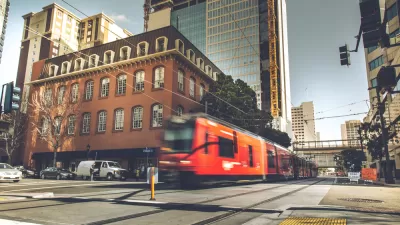In an age of rapid technological improvements in almost every aspect of life, it's difficult to understand how a technology like trains could actually be less advanced now than it was in the 1940s, writes Tom Vanderbilt.
"There is at least one technology in America...that is worse now than it was in the early 20th century: the train.
[Prewar train timetables show that] the Montreal Limited, circa 1942, would pull out of New York's Grand Central Station at 11:15 p.m., arriving at Montreal's (now defunct) Windsor Station at 8:25 a.m., a little more than nine hours later. To make that journey today, from New York's Penn Station on the Adirondack, requires a nearly 12-hour ride. The trip from Chicago to Minneapolis via the Olympian Hiawatha in the 1950s took about four and a half hours; today, via Amtrak's Empire Builder, the journey is more than eight hours. Going from Brattleboro, Vt., to New York City on the Boston and Maine Railroad's Washingtonian took less than five hours in 1938; today, Amtrak's Vermonter (the only option) takes six hours-if it's on time, which it isn't, nearly 75 percent of the time.
[President] Obama's bold vision [for high-speed rail] obscures a simple fact: 220 mph would be phenomenal, but we would also do well to simply get trains back up to the speeds they traveled during the Harding administration."
FULL STORY: Stop This Train!

Maui's Vacation Rental Debate Turns Ugly
Verbal attacks, misinformation campaigns and fistfights plague a high-stakes debate to convert thousands of vacation rentals into long-term housing.

Planetizen Federal Action Tracker
A weekly monitor of how Trump’s orders and actions are impacting planners and planning in America.

In Urban Planning, AI Prompting Could be the New Design Thinking
Creativity has long been key to great urban design. What if we see AI as our new creative partner?

King County Supportive Housing Program Offers Hope for Unhoused Residents
The county is taking a ‘Housing First’ approach that prioritizes getting people into housing, then offering wraparound supportive services.

Researchers Use AI to Get Clearer Picture of US Housing
Analysts are using artificial intelligence to supercharge their research by allowing them to comb through data faster. Though these AI tools can be error prone, they save time and housing researchers are optimistic about the future.

Making Shared Micromobility More Inclusive
Cities and shared mobility system operators can do more to include people with disabilities in planning and operations, per a new report.
Urban Design for Planners 1: Software Tools
This six-course series explores essential urban design concepts using open source software and equips planners with the tools they need to participate fully in the urban design process.
Planning for Universal Design
Learn the tools for implementing Universal Design in planning regulations.
planning NEXT
Appalachian Highlands Housing Partners
Mpact (founded as Rail~Volution)
City of Camden Redevelopment Agency
City of Astoria
City of Portland
City of Laramie





























